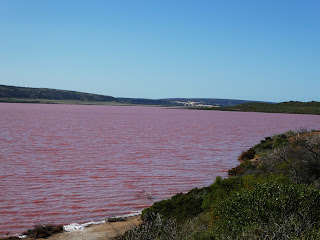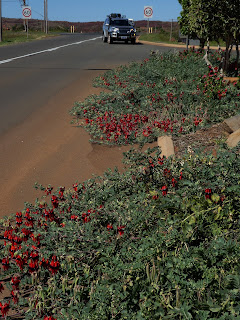 |
The chapel in the former boys' boarding
school.
|
New Norcia. What a sublime place. I can see why my friend
Maureen R. loves to visit it from Perth as we spent two glorious days there,
ate several times at the gracious hotel and enjoyed an extensive guided tour,
particularly into places not usually seen by people just wandering around.
The history of the place is wonderful and we loved prowling
around the museum which shows just how hard those early monks worked when it
was first established as a mission in the 1840s. The buildings are wonderful,
particularly the former boarding colleges for girls and boys, with glorious,
almost Renaissance-style chapels.
Even the hotel, gracious and with a Gone With The Wind
staircase, was built as a hostel for the visiting parents of the boarding
school students. It serves interesting meals, is
obviously the local watering
hole for the farm families around, and we sampled the Abbey ale and wines
bearing the New Norcia imprint.
 |
| The lovely hotel at New Norcia. |
While there we saw a poster at the visitors’ centre
advertising the Taste of Chittering. So when we had found Chittering on the map
just a bit south of New Norcia, and then discovered Toodyay (pronounced
Two-jay) had a lovely little bushland caravan park, we had an enormous journey
of about 98km from New Norcia. The caravan park was a joy, set outside Toodyay,
with ringneck parrots everywhere, ducks on a couple of dams, a tame peacock
called Henry, and a couple of emus kept behind a high fence.
Toodyay is a prosperous, historic town set in the wheatbelt,
very pretty, and a short drive through bushland and farmland from the Lower
Chittering Hall where the food fest was held on our second day there. It was
delightful, not nearly as big as the one we attended in Felton, south of
Toowoomba, in April. We found local honey, jams, asparagus, bakery goods,
coffees and even paella for lunch. There was a stall covered in wildflowers
from one of the local commercial plantations, which sells its flowers direct to
Holland and Japan, and even our guide from New Norcia turned up with a
colleague as they manned a stall with the New Norcia wines, oils, breads and
cakes.
After that, we actually headed east for a while to Wave
Rock, just outside a little town called Hyden. We arrived in the early
afternoon, so climbed the rock (helped by a few stairs and a chain which one
can use to help make the ascent). It wasn’t difficult and the surprise was
that, apart from the famous ‘wave’ in the rock, caused by millions of years of
water action, there is a dam formed by part of the rock and a dam wall built in
1928 so that the town would have water.
To get here we drove through several wheatbelt towns, all
very old, and our favourite probably was York, settled in the 1830s and still full
of some glorious old buildings. No centres are very far apart now that we’ve in
southern WA. It is very different from the hundreds of kilometres we’ve had to
travel in the real Outback just to reach the next town.
Tomorrow we head south, aiming to reach Denmark and then
Albany, sometime in the next few days. That will make it nine weeks on the
road, and almost 14,000km since we left home.
Sorry . . .Having computer/internet access troubles and can't upload any more pix.
Next post: The South
Coast of WA

























